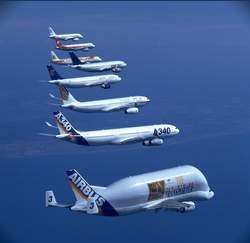Wed, Jun 18, 2003
 3D Systems Corp. announced just yesterday that
Airbus in the United Kingdom purchased an SLA® 7000 system to
produce components for wind tunnel testing at its operations in
Filton, Bristol. The purchase of an SLA 7000 system will be used to
create larger models with tighter tolerances and high quality
surface finish in the wind tunnel.
3D Systems Corp. announced just yesterday that
Airbus in the United Kingdom purchased an SLA® 7000 system to
produce components for wind tunnel testing at its operations in
Filton, Bristol. The purchase of an SLA 7000 system will be used to
create larger models with tighter tolerances and high quality
surface finish in the wind tunnel.
"My background for the last 5 years has been on the test side
where we are always under pressure to meet deadlines," said Martin
Aston wind tunnel domain manager for Airbus in Filton. "We were
already using 3D Systems technology through a third party service
bureau and were aware of some of the advantages of
stereolithography. If we are able to build models more quickly we
can enter the design cycle later, which gives the aerodynamicist
more time to think before committing to a test. We realized over a
year ago, rather than outsourcing our prototyping and model
production, that we needed to invest in new technology of our own
if we were going to improve our cycle times without lowering our
standards."
 "We are currently using the SLA 7000 system for
our Flight Physics which encompasses the aerodynamic groups who
submit new geometries for testing in the tunnel. Typical components
include leading edge and trailing edge configurations, flap tracks,
pylons and nacelles. Having our own SLA system on-site allows us to
react more quickly and more cost effectively to our bottom line,"
continued Aston. "We now try designs we never would have done
before because we have the technology on-site. Effectively we can
think of an idea, put it on the system to build overnight or over a
weekend and test it the next day. If the design doesn't work we
just repeat the process. To do that through a service bureau would
be almost impossible as the typical turnaround time is four
days."
"We are currently using the SLA 7000 system for
our Flight Physics which encompasses the aerodynamic groups who
submit new geometries for testing in the tunnel. Typical components
include leading edge and trailing edge configurations, flap tracks,
pylons and nacelles. Having our own SLA system on-site allows us to
react more quickly and more cost effectively to our bottom line,"
continued Aston. "We now try designs we never would have done
before because we have the technology on-site. Effectively we can
think of an idea, put it on the system to build overnight or over a
weekend and test it the next day. If the design doesn't work we
just repeat the process. To do that through a service bureau would
be almost impossible as the typical turnaround time is four
days."
Airbus has started experimenting with models that they would
never have attempted or thought possible previously. Producing
plastic models using the SLA system enables Airbus to cater for all
of the shapes and curves of aircraft components. Geometric form and
dimensional stability has been dramatically improved, which means
the test data is more accurate. By having the technology on-site a
deeper understanding of the process has been invaluable. This
knowledge allows the project coordinator to define and control
specific attributes of the geometry by understanding the
technology. They can then communicate these constraints with the
operator and part quality can be maintained.
"We no longer have the delay of waiting for returns if we need
to build a new iteration, we simply re-run it on the SLA system,"
stated Aston.
More News
Aero Linx: Model Aeronautical Association of Australia MAAA clubs are about fun flying, camaraderie and community. For over 75 years, the MAAA has been Australia’s largest fl>[...]
Touchdown Zone Lighting Two rows of transverse light bars located symmetrically about the runway centerline normally at 100 foot intervals. The basic system extends 3,000 feet alon>[...]
“Discovery and innovation are central to our mission at Virgin Galactic. We’re excited to build on our successful record of facilitating scientific experiments in subor>[...]
How To Get A Story On Aero-TV News/Feature Programming How do I submit a story idea or lead to Aero-TV? If you would like to submit a story idea or lead, please contact Jim Campbel>[...]
Student Pilot Reported That During Rotation, “All Of A Sudden The Back Of The Plane Kicked To The Right..." Analysis: The student pilot reported that during rotation, “>[...]
 ANN's Daily Aero-Linx (05.02.24)
ANN's Daily Aero-Linx (05.02.24) ANN's Daily Aero-Term (05.02.24): Touchdown Zone Lighting
ANN's Daily Aero-Term (05.02.24): Touchdown Zone Lighting Aero-News: Quote of the Day (05.02.24)
Aero-News: Quote of the Day (05.02.24) ANN FAQ: Contributing To Aero-TV
ANN FAQ: Contributing To Aero-TV NTSB Final Report: Cirrus Design Corp SR20
NTSB Final Report: Cirrus Design Corp SR20




